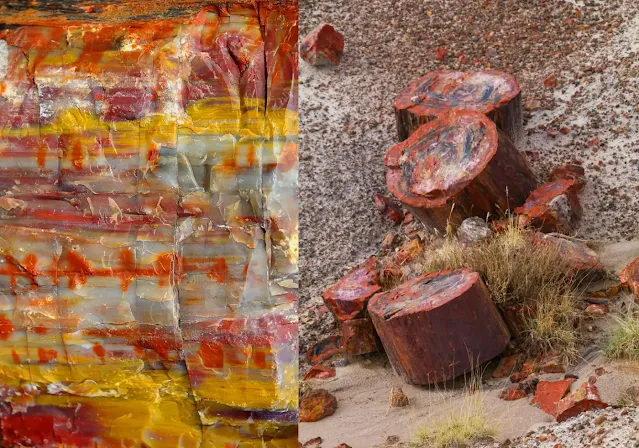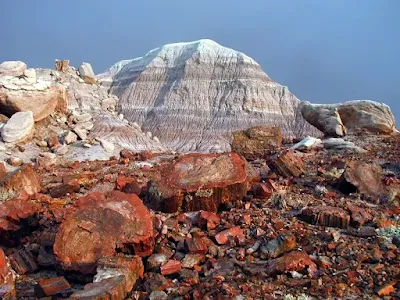Petrified Wood Forest: What It Is and How It Forms
Petrified Wood Forest: How Trees Turn to Stone
Petrified wood is a fossil in which the original organic material of wood has been replaced by minerals, usually silica. This process, called permineralization, takes millions of years and requires the wood to be buried in an environment that is low in oxygen and rich in silica.
The most common minerals found in petrified wood are quartz, chalcedony, and agate. These minerals are hard and durable, which is why petrified wood is often found in excellent condition. The color of petrified wood can vary depending on the minerals that replaced the original wood. Common colors include red, yellow, brown, and black.
Petrified wood is prized for its beauty and its unique properties. The mineralization process often preserves the original shape and structure of the wood, and it can also impart a variety of colors to the wood, including red, yellow, green, and blue. Petrified wood is often used as a decorative stone, and it can also be made into jewelry and other objects.
 |
| Natural Petrified wood at Petrified Forest National Park. Arizona Photo on the right by: Lon&Queta Photo on the left by: Diana Robinson |
How is Petrified Wood Forest Formed
The process of petrification begins when dead wood is buried in sediment. The sediment helps to protect the wood from decay, and it also provides the water and minerals that are necessary for the petrification process.
The minerals that replace the organic matter in the wood are most commonly silica, but other minerals such as calcite, pyrite, and opal can also be involved. The type of mineral that is present depends on the composition of the sediment and the groundwater.
The petrification process can take millions of years to complete. During this time, the minerals slowly replace the organic matter in the wood, cell by cell. The result is a rock-hard replica of the original tree.
 |
| Closeup petrified wood texture Photo: NPS-Stuart Holmes |
The process of petrification takes millions of years and requires the following conditions:
- The wood must be buried quickly in sediment or volcanic ash to prevent it from decaying.
- The sediment or ash must be rich in dissolved minerals, such as silica.
- The wood must be buried in an environment that is oxygen-poor, so that the minerals can replace the organic matter without being destroyed by bacteria or other organisms.
Where is Petrified Wood Forests Found
Petrified wood is found in many parts of the world. However, some of the most famous petrified wood deposits are found in the western United States.
 | |
| Petrified wood Attributed to Mesozoic of Madagascar Photo: James St. John |
Famous Petrified Forests Around the World
Petrified Forest National Park, USA: This iconic park in Arizona boasts an extensive collection of petrified wood, as well as vibrant desert landscapes and ancient petroglyphs.
Lesvos Petrified Forest, Greece: Home to some of the world's most well-preserved petrified trees, this site offers a glimpse into a lush subtropical forest from the Late Oligocene period.
Chinchilla Petrified Wood, Australia: Featuring a variety of colors and intricate patterns, the Chinchilla petrified wood deposit in Queensland is renowned for its visual appeal.
These deposits contain petrified trees that are millions of years old, and they offer a fascinating glimpse into the ancient forests that once covered the region.
What Are the Different Types of Petrified Wood?
There are many different types of petrified wood, depending on the type of mineral that has replaced the organic matter in the wood. Some of the most common types of petrified wood include:
- Siliceous petrifiedwood is the most common type of petrified wood. It is formed when silica, the main component of sand and quartz, replaces the organic matter in the wood. Siliceous petrified wood is often clear or translucent, and it can be a variety of colors, including red, yellow, green, and blue.
- Calcareous petrified wood is formed when calcite, a type of calcium carbonate, replaces the organic matter in the wood. Calcareous petrified wood is often white or cream-colored, and it is less likely to be translucent than siliceous petrified wood.
- Opalized petrified wood is formed when opal, a form of
silica, replaces the organic matter in the wood. Opalized petrified wood
is often milky white or translucent, and it can exhibit a rainbow of
colors.
How to Care for Petrified Wood
Petrified wood is a relatively durable material, but it can be damaged if it is not properly cared for. To protect your petrified wood, you should avoid exposing it to extreme temperatures or humidity. You should also avoid cleaning petrified wood with harsh chemicals.
If you are displaying your petrified wood, you should choose a location that is out of direct sunlight. You should also avoid placing petrified wood near heat sources, such as fireplaces or radiators.
 |
| Rainbow Forest petrified wood Photo: NPS-T Scott Williams |
Geological Significance and Uses
Petrified wood isn't just a stunning display of nature's artistry; it also has practical uses and geological significance. The preserved wood provides valuable insights into mineral deposition and groundwater movement. Additionally, petrified wood holds immense aesthetic and cultural value. It is often polished and used in jewelry, decorative art pieces, and even furniture. Museums and collectors worldwide cherish these fossils, using them to educate and inspire people about Earth's history.
Petrified wood has been used for centuries for a variety of purposes. In ancient times, it was used to make jewelry, tools, and weapons. Today, petrified wood is still used for decorative purposes, but it is also increasingly being used for scientific research.
Petrified wood can be used to study the evolution of plants and trees. By examining the petrified wood of ancient trees, scientists can learn about the climate and environment of the past. Petrified wood can also be used to study the history of fire. By examining the charred remains of petrified wood, scientists can learn about the earliest fires on Earth.
 |
| Buttes and petrified wood Credit NPS-T Scott Williams |
Facts About Petrified Wood Forests
- The oldest petrified wood in the world is about 390 million years old.
- The largest petrified tree in the world is located in the Petrified Forest National Park in Arizona. It is over 60 feet long and 10 feet wide.
- Petrified wood is often used in jewelry and other decorative items.
- Some people believe that petrified wood has healing properties.
- Petrified wood forests are a reminder of the power of nature and the beauty of the natural world.
- Petrified wood is also used in some construction materials, such as countertops and flooring.
See also:
Opalized Wood: Gemstone, Formation, Where to Find Opalized Wood?
Amber Colors: What Are the Different Colors of Amber?

%20(1).webp)






